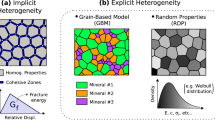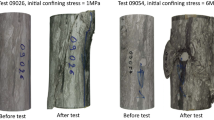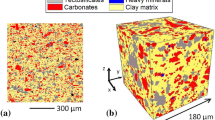Abstract
The Opalinus Clay (OPA) is an argillaceous rock formation selected to host a deep geologic repository for high-level nuclear waste in Switzerland. It has been shown that the excavation damaged zone (EDZ) in this formation is heavily affected by the anisotropic mechanical response of the material related to the presence of bedding planes. In this context, the purpose of this study is twofold: (i) to illustrate the new developments that have been introduced into the combined finite-discrete element method (FEM/DEM) to model layered materials and (ii) to demonstrate the effectiveness of this new modelling approach in simulating the short-term mechanical response of OPA at the laboratory-scale. A transversely isotropic elastic constitutive law is implemented to account for the anisotropic elastic modulus, while a procedure to incorporate a distribution of preferentially oriented defects is devised to capture the anisotropic strength. Laboratory results of indirect tensile tests and uniaxial compression tests are used to calibrate the numerical model. Emergent strength and deformation properties, together with the simulated damage mechanisms, are shown to be in strong agreement with experimental observations. Subsequently, the calibrated model is validated by investigating the effect of confinement and the influence of the loading angle with respect to the specimen anisotropy. Simulated fracture patterns are discussed in the context of the theory of brittle rock failure and analyzed with reference to the EDZ formation mechanisms observed at the Mont Terri Underground Research Laboratory.





















Similar content being viewed by others
References
Adhikary DP, Dyskin AV (1998) A continuum model of layered rock masses with non-associative joint plasticity. Int J Numer Anal Met 22(4):245–261
Amann F, Button EA, Evans KF, Gischig VS, Blümel M (2011) Experimental study of the brittle behaviour of clay shale in rapid unconfined compression. Rock Mech Rock Eng 44(4):415–430
Amann F, Kaiser PK, Button EA (2012) Experimental study of brittle behaviour of clay shale in rapid triaxial compression. Rock Mech Rock Eng 45(1):21–33
Barenblatt GI (1962) The mathematical theory of equilibrium cracks in brittle fracture. Adv Appl Mech 7 (C):55–129
Besuelle P, Chambon R, Collin F (2006) Switching deformation modes in post-localization solutions with a quasi-brittle material. J Mech Mater Struct 1(7):1115–1134
Bieniawski ZT (1967) Mechanism of brittle fracture of rock. Part I: theory of the fracture process. Int J Rock Mech Min Sci 4(4):395–406
Bieniawski ZT, Hawkes I (1978) Suggested methods for determining tensile strength of rock materials. Int J Rock Mech Min Sci 15:99–103
Blümling P, Bernier F, Lebon P, Martin CD (2007) The excavation damaged zone in clay formations time-dependent behaviour and influence on performance assessment. Phys Chem Earth 32(8–14):588–599
Bobet A, Einstein HH (1998a) Fracture coalescence in rock-type materials under uniaxial and biaxial compression. Int J Rock Mech Min Sci 35(7):863–888
Bobet A, Einstein HH (1998b) Numerical modeling of fracture coalescence in a model rock material. Int J Fracture 92(3):221–252
Bock H (2001) RA experiment. Rock mechanics analysis and synthesis: conceptual model of the Opalinus Clay. Mont Terri Technical Note 2001–02
Bock H (2009) RA Experiment. Updated review of the rock mechanics properties of the Opalinus Clay of the Mont Terri URL based on laboratory and field testing. Mont Terri Technical Report 2008–04
Bossart P, Meier PM, Moeri A, Trick T, Mayor J-C (2002) Geological and hydraulic characterisation of the excavation disturbed zone in the Opalinus Clay of the Mont Terri Rock Laboratory. Eng Geol 66(1–2):19–38
Brace WF, Bombolakis EG (1963) A note on brittle crack growth in compression. J Geophys Res 68(12):3709–3713
Brace WF, Paulding BW Jr, Scholz C (1966) Dilatancy in the fracture of crystalline rocks. Geophys Res Lett 71(16):3939–3953
Collin F, Chambon R, Charlier R (2006) A finite element method for poro-mechanical modelling of geotechnical problems using local second gradient models. Int J Numer Meth Eng 65(11):1749–1772
Corkum AG, Martin CD (2007) The mechanical behaviour of weak mudstone (Opalinus Clay) at low stresses. Int J Rock Mech Min Sci 44(2):196–209
Dedecker F, Cundall P, Billaux D, Groeger T (2007) Evaluation of damage-induced permeability using a three-dimensional adaptive continuum/discontinuum code (AC/DC). Phys Chem Earth 32(8–14):681–690
Diederichs MS (2000) Instability of hard rockmasses: the role of tensile damage and relaxation. PhD Thesis, University of Waterloo, Waterloo, Canada
Diederichs MS (2003) Manuel rocha medal recipient rock fracture and collapse under low confinement conditions. Rock Mech Rock Eng 36(5):339–381
Donath FA (1972) Effects of cohesion and granularity on deformational behavior of anisotropic rock. In: Doc BR, Smith DK (eds) Studies in Mineralogy and Precambrian Geology, vol 135. Geological Society of America, USA, pp 95–128
Dugdale DS (1960) Yielding of steel sheets containing slits. J Mech Phys Solids 8(2):100–104
Duveau G, Shao JF, Henry JP (1998) Assessment of some failure criteria for strongly anisotropic geomaterials. Mech Cohes-Frict Mat 3(1):1–26
Evans R, Marathe M (1968) Microcracking and stress-strain curves for concrete in tension. Mater Struct 1(1):61–64
Hillerborg A, Modeer M, Petersson P-E (1976) Analysis of crack formation and crack growth in concrete by means of fracture mechanics and finite elements. Cement Concrete Res 6(6):773–781
Hoek E, Brown ET (1980) Strength of jointed rock masses. Geotechnique 33(3):187–223
Horii H, Nemat-Nasser S (1986) Brittle failure in compression: splitting, faulting, and brittle-ductile transition. Philos T R Soc Lond 319:337–374
Itasca Consulting Group Inc (2012) FLAC. Fast Lagrangian Analysis of Continua, Version 7.0. Minneapolis, USA
Jaeger JC, Cook NGW (1976) Fundamentals of rock mechanics. Chapman & Hall, London
Jahns (2010) RA Experiment. Opalinus Clay rock characterization. Mont Terri Technical Note 2008–55rev
Jia P, Tang CA (2008) Numerical study on failure mechanism of tunnel in jointed rock mass. Tunn Undergr Sp Tech 23(5):500–507
Kaiser PK, Kim BH (2008) Rock mechanics advances of underground constructions and mining. In: Proceedings of the Korean rock mechanics symposium. Seoul, Korea, pp 1–6
Kemeny J, Cook NGW (1986) Effective moduli, non-linear deformation and strength of a cracked elastic solid. Int J Rock Mech Min Sci 23(2):107–118
Klinkenberg M, Kaufhold S, Dohrmann R, Siegesmund S (2009) Influence of carbonate microfabrics on the failure strength of claystones. Eng Geol 107(1–2):42–54
Konietzky H, Blümling P, teKamp L (2003) Opalinuston—Felsmechanische Untersuchungen. Interner Bericht 03-08, NAGRA, Wettingen, Switzerland
Labiouse V (2012) Hollow cylinder simulation experiments on Boom, Opalinus, Callovo-Oxfordian Clays. International Post-TIMODAZ Workshop, St-Ursanne, Switzerland, 6–7 February 2012
Labuz JF, Shah SP, Dowding CH (1985) Experimental analysis of crack propagation in granite. Int J Rock Mech Min Sci 22(2):85–98
Lan H, Martin CD, Hu B (2010) Effect of heterogeneity of brittle rock on micro-mechanical extensile behaviour during compression loading. J Geophys Res 115:1–14
Mahabadi OK (2012) Investigating the influence of micro-scale heterogeneity and microstructure on the failure and mechanical behaviour of geomaterials. PhD thesis, University of Toronto, Toronto, Canada
Mahabadi OK, Grasselli G, Munjiza A (2010) Y-GUI: A graphical user interface and pre-processor for the combined finite-discrete element code, Y2D, incorporating material inhomogeneity. Comput Geosci 36(2):241–252
Mahabadi OK, Lisjak A, Grasselli G, Munjiza A (2012a) Y-Geo: a new combined finite-discrete element numerical code for geomechanical applications. Int J Geomech. doi:10.1061/(ASCE)GM.1943-5622.0000216
Mahabadi OK, Randall NX, Zong Z, Grasselli G (2012b) A novel approach for micro-mechanical characterization and modelling of geomaterials incorporating actual material heterogeneity. Geophys Res Lett 39:L01303
Martin CD (1997) Seventeenth Canadian geotechnical colloquium: the effect of cohesion loss and stress path on brittle rock strength. Can Geotech J 34:239–254
McLamore R, Gray KE (1967) The mechanical behavior of anisotropic sedimentary rocks. J Eng Ind-T Asme 89:62–73
Munjiza A (2004) The combined finite-discrete element method. Wiley, Chichester
Munjiza A, Andrews KRF (2000) Discretised penalty function method in combined finite-discrete element analysis. Int J Num Meth Eng 49(11):1495–1520
Munjiza A, John NWM (2002) Mesh size sensitivity of the combined FEM/DEM fracture and fragmentation algorithms. Eng Fract Mech 69(2):281–295
Munjiza A, Owen DRJ, Bicanic N (1995) A combined finite-discrete element method in transient dynamics of fracturing solids. Eng Computation 12(2):145–174
Munjiza A, Andrews KRF, White JK (1999) Combined single and smeared crack model in combined finite-discrete element analysis. Int J Num Meth Eng 44(1):41–57
Naumann M, Hunsche U, Schulze O (2007) Experimental investigations on anisotropy in dilatancy, failure and creep of Opalinus Clay. Phys Chem Earth 32(8–14):889–895
Niandou H, Shao JF, Henry JP, Fourmaintraux D (1997) Laboratory investigation of the mechanical behavior of Tournemire shale. Int J Rock Mech Min Sci 34(1):3–16
Paterson MS, Wong T (2004) Experimental Rock Deformation—The Brittle Field. Springer, NewYork
Popp T, Salzer K (2007a) Anisotropy of seismic and mechanical properties of Opalinus Clay during triaxial deformation in a multi-anvil apparatus. Phys Chem Earth 32(8–14):879–888
Popp T, Salzer K (2007b) Laboratory tests on bedding planes. Mont Terri Technical Report 2007–04
Popp T, Salzer K, Minkley W (2008) Influence of bedding planes to EDZ-evolution and the coupled HM properties of Opalinus Clay. Phys Chem Earth 33:S374–S387
Potyondy D, Cundall P (2000) Bonded-particle simulations of the in situ failure test at Olkiluoto. International Progress Report 01–13, SKB, Stockholm, Sweden
Potyondy DO, Cundall PA (2004) A bonded-particle model for rock. Int J Rock Mech Min Sci 41(8):1329–1364
Riahi A, Curran JH (2009) Full 3D finite element Cosserat formulation with application in layered structures. Appl Math Model 33(8):3450–3464
Salager S, Nuth M, Laloui L (2010) Anisotropic features of the mechanical behaviour of Opalinus Clay. In: Zhao J, Labiouse V, Dudt J-P, Mathier J-F (eds) Proceedings of the European Rock Mechanics Symposium, Lausanne, Switzerland. Taylor & Francis Group, London
Seeska R, Lux K-H (2012) Borehole deformation measurements and video-observations of boreholes in the Opalinus Clay of the Mont Terri URL. International Post-TIMODAZ Workshop, St-Ursanne, Switzerland, 6–7 February 2012
Tang CA, Kaiser PK (1998) Numerical simulation of cumulative damage and seismic energy release during brittle rock failure - Part I: fundamentals. Int J Rock Mech Min Sci 35(2):113–121
Tang CA, Kou SQ (1998) Crack propagation and coalescence in brittle materials under compression. Eng Fract Mech 61(3–4):311–324
Tang CA, Lin P, Wong RHC, Chau KT (2001) Analysis of crack coalescence in rock-like materials containing three flaws—Part II: numerical approach. Int J Rock Mech Min Sci 38(7):925–939
Tapponnier P, Brace WF (1976) Development of stress-induced microcracks in Westerly Granite. Int J Rock Mech Min Sci 13(4):103–112
Tijssens MGA, Sluys BLG, van der Giessen E (2000) Numerical simulation of quasi-brittle fracture using damaging cohesive surfaces. Eur J Mech A-Solid 19(5):761–779
Ting TCT (1996) Anisotropic elasticity: theory and applications. Oxford University Press
Tsang C-F, Bernier F, Davies C (2005) Geohydromechanical processes in the excavation damaged zone in crystalline rock, rock salt, and indurated and plastic clays—in the context of radioactive waste disposal. Int J Rock Mech Min Sci 42(1):109–125
Turon A, Dávila CG, Camanho PP, Costa J (2007) An engineering solution to mesh size effects in the simulation of delamination using cohesive zone models. Eng Fract Mech 74(10):1665–1682
Vesga LF, Vallejo LE, Lobo-Guerrero S (2008) DEM analysis of the crack propagation in brittle clays under uniaxial compression tests. Int J Num Anal Meth 32(11):1405–1415
Vietor T, Li X, Fierz T (2012) In situ experiments in TIMODAZ. International Post-TIMODAZ Workshop, St-Ursanne, Switzerland, 6–7 February 2012
Wanne T (2002) Rock strength and deformation dependence on schistosity. Simulation of rock with PFC3D. Report 2002–05, Posiva Oy, Helsinki, Finland
Yan M (2008) Numerical modelling of brittle fracture and step-path failure: from laboratory to rock slope scale. PhD Thesis, Simon Fraser University, Burnaby, Canada
You S, Zhao G, Ji H (2011) Model for transversely isotropic materials based on distinct lattice spring model (DLSM). J Computer 6:1139–1144
Acknowledgments
This work has been supported by the Natural Science and Engineering Research Council of Canada in the form of Discovery Grant No. 341275 and by NAGRA.
Author information
Authors and Affiliations
Corresponding author
Rights and permissions
About this article
Cite this article
Lisjak, A., Tatone, B.S.A., Grasselli, G. et al. Numerical Modelling of the Anisotropic Mechanical Behaviour of Opalinus Clay at the Laboratory-Scale Using FEM/DEM. Rock Mech Rock Eng 47, 187–206 (2014). https://doi.org/10.1007/s00603-012-0354-7
Received:
Accepted:
Published:
Issue Date:
DOI: https://doi.org/10.1007/s00603-012-0354-7




